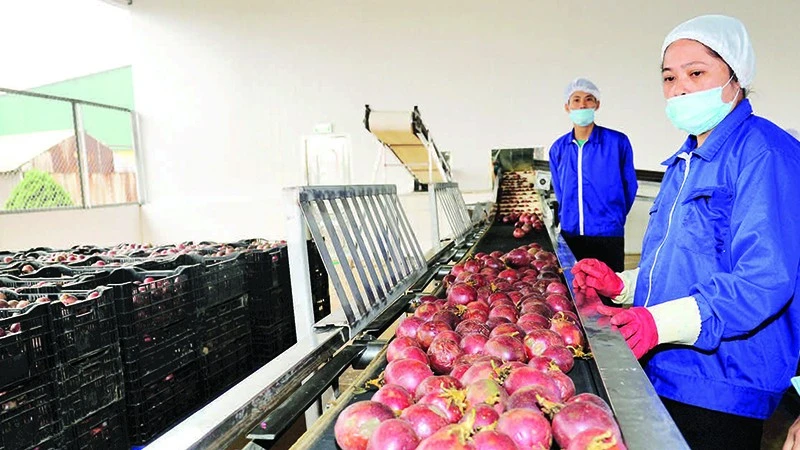Building a new strategy for fruit sector
In the first six months of 2025, Viet Nam’s fruit export turnoversharply declined after two consecutive years of strong growth. The sector needs a strategy to enhance competitive advantages, focusing on potential products that are on track to reach and surpass the one-billion-USD mark, such as bananas, pineapples, coconuts, and passion fruit.

According to the Department of Crop Production and Plant Protection (Ministry of Agriculture and Environment), the country currently has more than 1.3 million hectares of fruit trees, with an annual output of about 15 million tonnes. Among them, bananas cover 161,000 hectares; pineapples over 52,000 hectares; coconuts nearly 202,000 hectares; and passion fruit over 12,000 hectares.
Great potential, low value
According to Deputy Director of Science and Technology (Ministry of Agriculture and Environment) Nguyen Nhu Cuong, the group of fruit trees is asserting its role as a driver of agricultural growth, increasing farmers’ incomes and making an important contribution to agricultural export turnover.
However, so far, only durian has entered the “Billion-USD Export Club”; passion fruit, bananas, pineapples, and coconuts have many advantages and export potential but have not reached the desired export value.
Specifically, in 2024, Viet Nam’s banana export value reached 380 million USD, equivalent to 2.5% of the global banana trade value (15.3 billion USD). Currently, Viet Nam ranks ninth among banana-exporting countries worldwide.
Pham Quoc Liem, Chairman of the Board of Directors and General Director of U&I Agricultural Joint Stock Company (Unifarm), said that based on total banana export turnover and current banana acreage, the average value is about 2,400 USD/hectare/year, which is low compared to potential.
“We expect Viet Nam’s banana sector to achieve export value of up to 4 billion USD in the future, rising to lead the global banana industry. This goal is not easy but entirely feasible if businesses and cooperatives join forces in large-scale production, apply high technology, and maintain uniform product quality,” Liem affirmed.
As for passion fruit, Viet Nam currently ranks among the top 10 largest producers and exporters in the world. About 70–80% of fresh and processed passion fruit output is exported to more than 20 countries and territories.
In 2024, passion fruit exports reached 172 million USD. In the first five months of 2025, passion fruit product exports brought in 89.5 million USD, up 14.5% compared to the same period in 2024.
This is also a product expected to soon join the billion-USD export group. Particularly, Viet Nam’s purple passion fruit is being strongly welcomed worldwide in fresh form due to its difference from South America’s yellow passion fruit.
No less potential than passion fruit is pineapple, with projected production expected to reach 807,000 tonnes by 2026. Viet Nam’s pineapple products have been exported to European countries, the US, China, Japan, Australia.
According to forecasts, the global pineapple market could reach 36.8 billion USD by 2028. However, as of the end of May 2025, Viet Nam’s largest pineapple export market is Europe, with export value reaching 16.56 million USD, followed by the US market with 7.2 million USD in turnover.
Investing in varieties and technology
Deputy Minister of Agriculture and Environment Tran Thanh Nam said that global market demand for passion fruit, pineapple, coconut, and banana is increasing, with many businesses reporting insufficient supply to meet demand. But to elevate these products to billion-USD export status, a “technological revolution” is needed, in which varieties play an important role.
If the sector is not reorganised now, Viet Nam will lose its advantage and fall behind other countries in the same geographical area. Therefore, it is necessary to strengthen research into new varieties, such as disease-free passion fruit for fresh consumption; disease-resistant bananas (especially against Panama wilt); high-yield pineapples suitable for processing; and high-yield fresh coconuts for export…
The “core production zones” need to be clearly defined, with quality control and technology integration as a foundation for registering planting area codes and traceability.
According to Nguyen Manh Hung, Chairman of the Board of Directors of Nafoods Joint Stock Company, to facilitate businesses, there needs to be policy support allowing companies to allocate profits for reinvestment in research and technology development, and specific policies on technology imports. For example, in grafting passion fruit varieties, it is necessary to import varieties from many countries, as well as import substrates, fertilisers, tape, cutting knives…
Therefore, businesses very much hope for clear regulations so that imports can proceed quickly and effectively. If policies are favourable, many businesses are ready to join in promoting the application of science and technology in the field of plant varieties.
In addition to variety selection technology, fruits such as passion fruit, bananas, and pineapples are all prone to spoilage after harvest, so suitable preservation technology is needed.
According to Pham Anh Tuan, Director of the Institute of Agricultural Engineering and Post-Harvest Technology, many outstanding technologies have been researched, mastered, and successfully transferred by the Institute: fresh fruit preservation technology using film-forming agents; heat pump drying technology to preserve colour, aroma, and nutrients; freeze-drying to maximise quality and extend shelf life; ultra-fast freezing using liquid to reduce freezing time to just 18–20 minutes, cutting electricity costs by 50% compared to IQF technology, with investment costs only 30% of those for Japanese imports.








